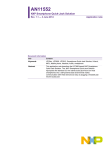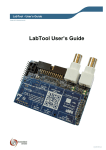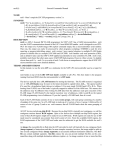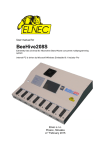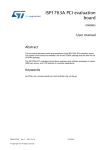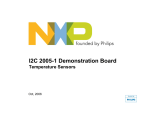Download UM10815
Transcript
UM10815 NXP Smartphone Quick-Jack Solution quick start guide Rev. 1 — 19 May 2014 User manual Document information Info Content Keywords LPC8xx, LPC800, LPC812, Smartphone Quick-Jack Solution, HiJack, MCU, Mobile phone, Headset, Audio, smartphone Abstract This quick start guide explains how to get up and running with the Smartphone Quick-Jack Solution. UM10815 NXP Semiconductors NXP Smartphone Quick-Jack Solution quick start guide Revision history Rev Date Description 1 Initial version. 20140519 Contact information For more information, please visit: http://www.nxp.com For sales office addresses, please send an email to: [email protected] UM10815 User manual All information provided in this document is subject to legal disclaimers. Rev. 1 — 19 May 2014 © NXP B.V. 2014. All rights reserved. 2 of 12 UM10815 NXP Semiconductors NXP Smartphone Quick-Jack Solution quick start guide 1. Introduction Inspired by the University of Michigan's Project HiJack, the NXP Smartphone Quick-Jack Solution repurposes the standard 3.5 mm stereo audio jack found on most smartphones into a self-powered data channel that makes communication with these smartphones as easy as plugging a headset jack into the audio port. The Quick-Jack demo board integrates a joystick, temperature sensor, LEDs and an expansion header. The app running on the smartphone is able to interface with these onboard peripherals via the Quick-Jack interface. Quick-Jack’s main features: • Demo board uses the low-power LPC812 microcontroller in TSSOP20 package • Board is powered by either the smartphone or a small button battery 2 • SE98 I C temperature sensor integrated on the demo board • Control the four on-board LEDs from the smartphone • Read input from on-board joystick • Quick-Jack app available for iOS and Android smartphones • Expansion header featuring most of the LPC800 GPIO pins • Board features standard ARM SWD debug interface (10 pins, 1.27 mm) The Quick-Jack board can be ordered through a variety of distributors using order number OM13069. UM10815 User manual All information provided in this document is subject to legal disclaimers. Rev. 1 — 19 May 2014 © NXP B.V. 2014. All rights reserved. 3 of 12 UM10815 NXP Semiconductors NXP Smartphone Quick-Jack Solution quick start guide Fig 1. NXP Smartphone Quick-Jack Solution UM10815 User manual All information provided in this document is subject to legal disclaimers. Rev. 1 — 19 May 2014 © NXP B.V. 2014. All rights reserved. 4 of 12 UM10815 NXP Semiconductors NXP Smartphone Quick-Jack Solution quick start guide 2. NXP Quick-Jack Quick Start Guide This Quick Start Guide explains how to get up and running with the Quick-Jack solution. 2.1 Hardware requirements The Quick-Jack solution requires the NXP Quick-Jack board (OM13069) and a compatible smartphone. Quick-Jack has been tested and verified to work on the following smartphones: • iOS: iPhone 4, iPhone 4S, iPhone 5, iPhone 5S • Android: Samsung Galaxy S3. Other phones are not currently guaranteed to work. 2.2 Software requirements The Quick-Jack board ships pre-programmed. The latest version of the firmware, including the source code, can be found on http://www.lpcware.com/quick-jack. The smartphone example app can be downloaded from the App Store (iOS). The Android App (APK) and source code can be downloaded from http://www.lpcware.com/quick-jack. 2.3 Getting up and running To get up and running with Quick-Jack, follow these steps: 1. Download and install the app. The app can be downloaded from the App Store (iOS). The app can be found in the app-store by searching for ‘NXP Quick-Jack’. 2. Make sure the coin cell battery (size CR1220) is inserted and that the jumpers on the Quick-Jack board are set to default (Fig 2). Fig 2. Coin cell battery inserted, jumpers set to default configuration (JP2 on both positions, JP3 placed on the right position) 3. Insert the Quick-Jack board in the phone’s audio jack. Then, configure the mediavolume/headset-volume on the phone to maximum volume (Fig 3). UM10815 User manual All information provided in this document is subject to legal disclaimers. Rev. 1 — 19 May 2014 © NXP B.V. 2014. All rights reserved. 5 of 12 UM10815 NXP Semiconductors NXP Smartphone Quick-Jack Solution quick start guide Fig 3. Phone’s media-volume/headset-volume set to maximum (illustration shown for Samsung S3) 4. Start the app. As soon as the app is running, LED LD0 should be lit and LED LD4 should be blinking (Fig 4). LD0 LD4 Fig 4. UM10815 User manual After starting the Quick-Jack app, LD0 will be lit and LD4 will be blinking All information provided in this document is subject to legal disclaimers. Rev. 1 — 19 May 2014 © NXP B.V. 2014. All rights reserved. 6 of 12 UM10815 NXP Semiconductors NXP Smartphone Quick-Jack Solution quick start guide After establishing initial connection (LD4 blinking), the Quick-Jack board can be controlled from the app: • By adjusting the slider, the blink rate of LD4 can be changed (faster/slower). • By clicking the LED1/LED2/LED3 buttons, on-board LEDs LD1 to LD3 can be toggled on and off (Fig 5). • The state of the on-board joystick is reflected on the circle in the app. Fig 5. State of the on-board joystick is reflected in the app • If the Enable KEYs button is pressed, the joystick image will no longer be displayed (Fig 6). It can be re-enabled by pressing Disable KEYs. UM10815 User manual All information provided in this document is subject to legal disclaimers. Rev. 1 — 19 May 2014 © NXP B.V. 2014. All rights reserved. 7 of 12 UM10815 NXP Semiconductors NXP Smartphone Quick-Jack Solution quick start guide Fig 6. If Disable KEYs is displayed the joystick position is no longer visible • Clicking on the sensor tab (top right in the app) shows the temperature sensor interface. After clicking the Begin button, the current temperature as measured by the on-board SE98 sensor will be displayed and a temperature vs. time graph will be plotted (Fig 7). Note that when the sensor tab is opened, LD4 stops blinking; when returning to the LEDs tab LD4 resumes blinking. Fig 7. UM10815 User manual Environment temperature measured by the SE98 temperature sensor All information provided in this document is subject to legal disclaimers. Rev. 1 — 19 May 2014 © NXP B.V. 2014. All rights reserved. 8 of 12 UM10815 NXP Semiconductors NXP Smartphone Quick-Jack Solution quick start guide • Press the phone’s Return button (Android) or the phone’s Home button (iOS) to exit the app. 2.4 Jumper settings Two jumper headers are available on the Quick-Jack board, jumpers JP2 and JP3 (Fig 8): • JP2 (Power) - Power supply select. Four-pin header JP2 allows placing two jumpers. The left (outer) jumper connects the energy-harvester to the input of the LDO, the right (inner) jumper connects the coin cell battery to the input of the LDO. Diodes prevent current flowing from one source into the other, allowing Quick-Jack to be powered by both the battery and the energy-harvester at the same time. This operation is advised when using Quick-Jack and is the default setting. • JP3 (Communication) – Left-channel audio signal path select. This jumper can be positioned in either the left- or right position. When placed on the right two pins, the phone’s left-channel audio signal – the signal with the Manchester encoded data – is routed through the on-board comparator (default mode). • When placed on the left two pins, the on-board comparator is bypassed and the analog signal is fed straight into the LPC812. In this case, the LPC812’s internal comparator must be enabled and configured in order to convert the phone’s analog data to digital data. Note that this mode is not supported in the default firmware. Fig 8. UM10815 User manual Jumper JP2 and JP3 and their default position All information provided in this document is subject to legal disclaimers. Rev. 1 — 19 May 2014 © NXP B.V. 2014. All rights reserved. 9 of 12 UM10815 NXP Semiconductors NXP Smartphone Quick-Jack Solution quick start guide 3. Legal information 3.1 Definitions Draft — The document is a draft version only. The content is still under internal review and subject to formal approval, which may result in modifications or additions. NXP Semiconductors does not give any representations or warranties as to the accuracy or completeness of information included herein and shall have no liability for the consequences of use of such information. 3.2 Disclaimers Limited warranty and liability — Information in this document is believed to be accurate and reliable. However, NXP Semiconductors does not give any representations or warranties, expressed or implied, as to the accuracy or completeness of such information and shall have no liability for the consequences of use of such information. In no event shall NXP Semiconductors be liable for any indirect, incidental, punitive, special or consequential damages (including - without limitation lost profits, lost savings, business interruption, costs related to the removal or replacement of any products or rework charges) whether or not such damages are based on tort (including negligence), warranty, breach of contract or any other legal theory. Notwithstanding any damages that customer might incur for any reason whatsoever, NXP Semiconductors’ aggregate and cumulative liability towards customer for the products described herein shall be limited in accordance with the Terms and conditions of commercial sale of NXP Semiconductors. Right to make changes — NXP Semiconductors reserves the right to make changes to information published in this document, including without limitation specifications and product descriptions, at any time and without notice. This document supersedes and replaces all information supplied prior to the publication hereof. Suitability for use — NXP Semiconductors products are not designed, authorized or warranted to be suitable for use in life support, life-critical or safety-critical systems or equipment, nor in applications where failure or malfunction of an NXP Semiconductors product can reasonably be expected to result in personal injury, death or severe property or environmental damage. NXP Semiconductors accepts no liability for inclusion and/or use of NXP Semiconductors products in such equipment or applications and therefore such inclusion and/or use is at the customer’s own risk. Applications — Applications that are described herein for any of these products are for illustrative purposes only. NXP Semiconductors makes no representation or warranty that such applications will be suitable for the specified use without further testing or modification. whether the NXP Semiconductors product is suitable and fit for the customer’s applications and products planned, as well as for the planned application and use of customer’s third party customer(s). Customers should provide appropriate design and operating safeguards to minimize the risks associated with their applications and products. NXP Semiconductors does not accept any liability related to any default, damage, costs or problem which is based on any weakness or default in the customer’s applications or products, or the application or use by customer’s third party customer(s). Customer is responsible for doing all necessary testing for the customer’s applications and products using NXP Semiconductors products in order to avoid a default of the applications and the products or of the application or use by customer’s third party customer(s). NXP does not accept any liability in this respect. Export control — This document as well as the item(s) described herein may be subject to export control regulations. Export might require a prior authorization from competent authorities. Evaluation products — This product is provided on an “as is” and “with all faults” basis for evaluation purposes only. NXP Semiconductors, its affiliates and their suppliers expressly disclaim all warranties, whether express, implied or statutory, including but not limited to the implied warranties of noninfringement, merchantability and fitness for a particular purpose. The entire risk as to the quality, or arising out of the use or performance, of this product remains with customer. In no event shall NXP Semiconductors, its affiliates or their suppliers be liable to customer for any special, indirect, consequential, punitive or incidental damages (including without limitation damages for loss of business, business interruption, loss of use, loss of data or information, and the like) arising out the use of or inability to use the product, whether or not based on tort (including negligence), strict liability, breach of contract, breach of warranty or any other theory, even if advised of the possibility of such damages. Notwithstanding any damages that customer might incur for any reason whatsoever (including without limitation, all damages referenced above and all direct or general damages), the entire liability of NXP Semiconductors, its affiliates and their suppliers and customer’s exclusive remedy for all of the foregoing shall be limited to actual damages incurred by customer based on reasonable reliance up to the greater of the amount actually paid by customer for the product or five dollars (US$5.00). The foregoing limitations, exclusions and disclaimers shall apply to the maximum extent permitted by applicable law, even if any remedy fails of its essential purpose. 3.3 Trademarks Notice: All referenced brands, product names, service names and trademarks are property of their respective owners. Customers are responsible for the design and operation of their applications and products using NXP Semiconductors products, and NXP Semiconductors accepts no liability for any assistance with applications or customer product design. It is customer’s sole responsibility to determine UM10815 User manual All information provided in this document is subject to legal disclaimers. Rev. 1 — 19 May 2014 © NXP B.V. 2014. All rights reserved. 10 of 12 UM10815 NXP Semiconductors NXP Smartphone Quick-Jack Solution quick start guide 4. List of figures Fig 1. Fig 2. Fig 3. Fig 4. Fig 5. Fig 6. Fig 7. Fig 8. NXP Smartphone Quick-Jack Solution ............. 4 Coin cell battery inserted, jumpers set to default configuration (JP2 on both positions, JP3 placed on the right position) ......................................... 5 Phone’s media-volume/headset-volume set to maximum (illustration shown for Samsung S3) . 6 After starting the Quick-Jack app, LD0 will be lit and LD4 will be blinking .................................... 6 State of the on-board joystick is reflected in the app .................................................................... 7 If Disable KEYs is displayed the joystick position is no longer visible ............................................ 8 Environment temperature measured by the SE98 temperature sensor ................................. 8 Jumper JP2 and JP3 and their default position . 9 UM10815 User manual All information provided in this document is subject to legal disclaimers. Rev. 1 — 19 May 2014 © NXP B.V. 2014. All rights reserved. 11 of 12 UM10815 NXP Semiconductors NXP Smartphone Quick-Jack Solution quick start guide 5. Contents 1. 2. 2.1 2.2 2.3 2.4 3. 3.1 3.2 3.3 4. 5. Introduction ......................................................... 3 NXP Quick-Jack Quick Start Guide.................... 5 Hardware requirements ...................................... 5 Software requirements ....................................... 5 Getting up and running ....................................... 5 Jumper settings .................................................. 9 Legal information .............................................. 10 Definitions ........................................................ 10 Disclaimers....................................................... 10 Trademarks ...................................................... 10 List of figures..................................................... 11 Contents ............................................................. 12 Please be aware that important notices concerning this document and the product(s) described herein, have been included in the section 'Legal information'. © NXP B.V. 2014. All rights reserved. For more information, please visit: http://www.nxp.com For sales office addresses, please send an email to: [email protected] Date of release: 19 May 2014 Document identifier: UM10815












